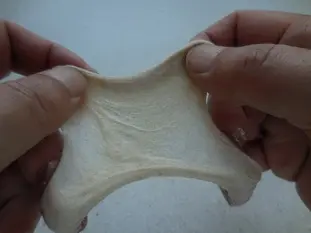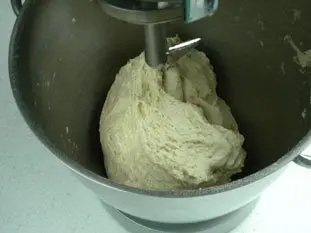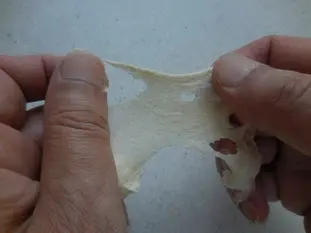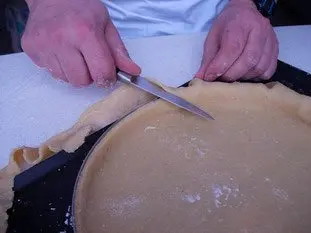This site uses only a few technical cookies necessary for its operation. By continuing to browse, you accept their use.
To find out more...
To find out more...
The window-pane test in bread-making

The home bread-makers often ask themselves “Have I kneaded my dough long enough?” . A good question, as dough that is insufficiently kneaded will not rise properly or will fall flat when the top is slashed, which is very frustrating.
To know when the dough is ready, one can rely on the length of kneading time shown in the recipe or test the temperature, but both can be unreliable guides. It is better to check visually if the dough is sufficiently well kneaded. Then one can say, “OK, let's stop there” , or “No, that needs a bit longer” .
To check the dough visually, like the professionals do, we need to check for the “window-pane” effect, also known as the membrane test.
To know when the dough is ready, one can rely on the length of kneading time shown in the recipe or test the temperature, but both can be unreliable guides. It is better to check visually if the dough is sufficiently well kneaded. Then one can say, “OK, let's stop there” , or “No, that needs a bit longer” .
To check the dough visually, like the professionals do, we need to check for the “window-pane” effect, also known as the membrane test.
Last modified on: June 16th 2021
The window-pane test in bread-making
Behind this mysterious name lies a very physical phenomenon: when dough is kneaded, the gluten in the flour forms a structure, like a kind of net, which holds the dough together. This gluten network gives the dough its elasticity and traps the C02 formed during fermentation to create the “bubbles” which will become the open spaces in the bread.
If you stretch well-kneaded dough, the gluten network will prevent it breaking immediately, so it is possible to stretch it out very thinly, indicating that the gluten network is properly developed.
So, the test is very simple: if the membrane is there, the dough has been kneaded long enough. If not, continue kneading.
To sum up :The presence or absence of the translucent membrane is the best indicator of whether bread dough is sufficiently kneaded or not.
But not all dough in baking is the same: this membrane should be looked for in bread dough as a sign of elasticity. However, for tart pastry, it is quite the contrary: we don't want the dough to be stretchy and develop the gluten membrane. So, for pastry, the dough should be kneaded as little as possible.
If you stretch well-kneaded dough, the gluten network will prevent it breaking immediately, so it is possible to stretch it out very thinly, indicating that the gluten network is properly developed.
So, the test is very simple: if the membrane is there, the dough has been kneaded long enough. If not, continue kneading.

Now, of course, we need to know how to check whether the membrane is there or not.
To do this, stop kneading and take a small piece of dough, about the size of a walnut. Stretch this out gently: if the dough tears easily, the membrane is not yet developed and you will need to continue kneading, like in this photo:

If, on the contrary, the dough does not tear, but can be stretched out into a thin, translucent membrane, you can stop kneading. This is shown here:

Here ios a small video to show you the gesture and the result:
To sum up :The presence or absence of the translucent membrane is the best indicator of whether bread dough is sufficiently kneaded or not.
But not all dough in baking is the same: this membrane should be looked for in bread dough as a sign of elasticity. However, for tart pastry, it is quite the contrary: we don't want the dough to be stretchy and develop the gluten membrane. So, for pastry, the dough should be kneaded as little as possible.

Lasts posts
Butter vs. grease
We often read in a recipe where a pastry is put into a mould that, just before pouring, the mould should be buttered or greased. But what's the difference between these 2 terms?December 1st 20257875
Getting out of the fridge early
Very often when you're cooking, you need to take food or preparations out of the fridge, to use them in the recipe in progress. There's nothing tricky about this: you just take them out of the fridge and use them, usually immediately, in the recipe. But is this really a good method?November 24th 20251,0105
Who's making the croissants?
When you look at a bakery from the outside, you naturally think that in the bakery, the bakers make the bread, and in the laboratory, the pastry chefs make the cakes. It's very often like that, with each of these professions having quite different ways of working, but sometimes there's also one...November 23th 2025908
Oven height
When we put a dish or cake in the oven, we naturally tend to put it on the middle shelf, and that's what we usually do. But in some cases, this position and height can be a little tricky, so let's find out why.October 8th 20252,5335
The importance of sieving
In recipes that use a fine powder (flour, powdered sugar, etc.), you'll often see the advice to sift before using it. To sift is to pass the powder in question through a sieve (a very fine strainer) before incorporating it into your recipe. It's often advice, but is it really useful?September 3rd 20257,3943
Other pages you may also like
Candied fruits: don't get ripped off
Do you like candied fruit? You might like to nibble a handful or add it to a recipe, like a classic fruit cake or delicious Italian specialities like panettone or sicilian epiphany pie.June 21th 201767 K 24.2
Butter vs. grease
We often read in a recipe where a pastry is put into a mould that, just before pouring, the mould should be buttered or greased. But what's the difference between these 2 terms?December 1st 20257875
What is the difference between bakery and patisserie?
This is a question that you may well have asked yourself and which I will attempt to answer. In France the two trades of "boulangerie" (bakery) and "pâtisserie" (patisserie and confectionery) have always been quite distinct, but where exactly do the boundaries lie? .February 7th 2017134 K 14.1
Tranché, dissociated, failed, in short... missed!
When preparing a sauce or a cream, there's always a (small) risk that the creamy preparation you're working on will suddenly separate into two parts of different textures: a liquid part, for example, and a more or less solid part, or even become lumpy. It's terribly frustrating, but we'll see...June 19th 202313 K5
Oven height
When we put a dish or cake in the oven, we naturally tend to put it on the middle shelf, and that's what we usually do. But in some cases, this position and height can be a little tricky, so let's find out why.October 8th 20252,5335
Follow this page
If you are interested in this page, you can "follow" it, by entering your email address here. You will then receive a notification immediately each time the page is modified or a new comment is added. Please note that you will need to confirm this following.
Note: We'll never share your e-mail address with anyone else.
Alternatively: you can subscribe to the mailing list of cooling-ez.com , you will receive a e-mail for each new recipe published on the site.








The 2 comments already posted on this page
Professional baker (good ones) make it a dozen a day, because they want to be sure of their doughs, despite the flour, temperature of the day, hydrometry, amount of water, etc.
But I think you're wrong when you say you could check "kneaded sufficient just by the way it looks and feels", sorry, no, it's a beginner mistake (believe me, I made it some time... when I was in bakery school) looking at the dough and claim that it's enough, especially if you have soft doughs like milk rolls, who could be smooth, because of the butter and milk in, but not enough kneaded.
And I don't agree neither when you say "it's usually better to err on the side of overkneading than underkneading", no, it's the opposite when overkneaded, it's over, failed, can't be fixed, but if you're underkneaded, you can fix it by a longer first rest (pointage) than usually planned.